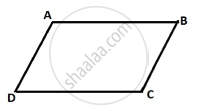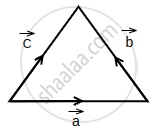Advertisements
Advertisements
Question
The position vectors of three consecutive vertices of a parallelogram are `hat"i" + hat"j" + hat"k", hat"i" + 3hat"j" + 5hat"k"` and `7hat"i" + 9hat"j" + 11hat"k"`. Find the position vector of the fourth vertex.
Solution
Let, `bar"a" = hat"i" + hat"j" + hat"k"`
`bar"b" = hat"i" + 3hat"j" + 5hat"k"`
`bar"c" = 7hat"i" + 9hat"j" + 11hat"k"`
and `bar"d"` be the position vectors of four vertices of parallelogram ABCD.

∴ `bar"AB" = bar"DC"` ....[Opposite sides of parallelogram]
∴ `bar"b" - bar"a" = bar"c" - bar"d"`
∴ `bar"d" = bar"a" + bar"c" - bar "b"`
∴ `bar"d" = (hat"i" + hat"j" + hat"k") + (7hat"i" + 9hat"j" + 11hat"k") - (hat"i" + 3hat"j" + 5hat"k")`
= `(1 + 7 - 1)hat"i" + (1 + 9 - 3)hat"j" - (1 + 11 - 5)hat"k"`
= `7hat"i" + 7hat"j" + 7hat"k"`
= `7(hat"i" + hat"j" + hat"k")`
∴ Position vector of the fourth vertex of the parallelogram is `7(hat"i" + hat"j" + hat"k")`.
APPEARS IN
RELATED QUESTIONS
If `bara and barb` are any two non-zero and non-collinear vectors then prove that any vector `barr` coplanar with `bara` and `barb` can be uniquely expressed as `barr = t_1bara + t_2barb` , where t1 and t2 are scalars.
Find a unit vector in the opposite direction of `bar("u")`. Where `bar("u") = 8hat"i" + 3hat"j" - hat"k"`
Represent graphically the displacement of 45 cm, 30° north of east
Represent graphically the displacement of 80 km, 60° south of west
If `(bar"a" + 2bar"b" - bar"c") * [(bar"a" - bar"b") xx (bar"a" - bar"b" - bar"c")] = "k"[bar"a" bar"b" bar"c"]`, then the value of k is
A line makes angles α, β, γ with the co-ordinate axes and α + β = 90°, then γ = ______.
The angle between two adjacent sides `overlinea` and `overlineb` of parallelogram is `pi/6`. if `overlinea` = (2, -2, 1) and `|overlineb| = 2|overlinea|`, then area of this parallelogram is ______
If C is the midpoint of AB and P is any point outside AB, then ______
Which of the following is not equal to w · (u × v)?
If `overline (a) =10hat("i") + lambda hat("j") + 2hat("k")` is perpendicular to `overline (b)= hat ("i")+hat("j")-hat("k")`, then λ is equal to ______.
If `veca + vecb = vecc ((λx)hati + yhatj + 4zhatk) + (yhati + xhatj + 3yhatk) = -zhati - 2zhatj - (λ + 1)xhatk` are sides of triangle as shown is figure then value of λ is ______.
(where x, y, z are not all zero)

If a = `veca = hati + hatj - 2hatk, vecb = 2hati - hatj + hatk` and `vecc = 3hati - hatk` and `vecc = mveca + nvecb`, then m + n is equal to ______.
If `veca = hati - hatj + hatk, vecb = 2hati + λhatj + hatk, vecc = hati - hatj + 4hatk` and `veca.(vecb xx vecc)` = 10, then λ is equal to ______.
Let a = `hati + 2hatj + hatk`, b = `hati - hatj + hatk`, c = `hati + hatj - hatk`. A vector coplanar to a and b has a projection along with c of magnitude `1/sqrt(3)`, then the vector is ______.
If a, b and c are three non-zero vectors which are pairwise non-collinear. If a + 3b is collinear with c and b + 2c is collinear with a, then a + 3b + 6c is ______.
The position vectors of vertices of ΔABC are `4hati - 2hatj; hati + 4hatj - 3hatk` and `-hati + 5hatj + hatk` respectively, then ∠ABC = ______.
If a = `3hati - 2hatj + hatk` and b = `2hati - 4hatj - 3hatk`, then | a – 2b | will be ______.
The area of the triangle with vertices (1, 2, 0), (1, 0, 2) and (0, 3, 1) in sq. unit is ______.
In the triangle PQR, `bar("PQ") = 2bar "a"` and `bar("QR") = 2bar "b".` The mid-point of PR is M. Find the following vectors in terms of `bar "a" "and" bar"b"`.
Check whether the vectors `2hati + 2hatj + 3hatk, -3hati + 3hatj + 2hatk, "and" 3hati + 4hatk` form a triangle or not.
In the triangle PQR, `bar(PQ)` = 2 `bara` and `bar(QR)` = 2 `barb`. The mid-point of PR is M. Find the following vectors in terms of `bara` and `barb`.
- `bar(PR)`
- `bar(PM)`
- `bar(QM)`
Check whether the vectors `2hati + 2hatj+3hatk,-3hati+3hatj+2hatk` and `3hati+4hatk` form a triangle or not.
